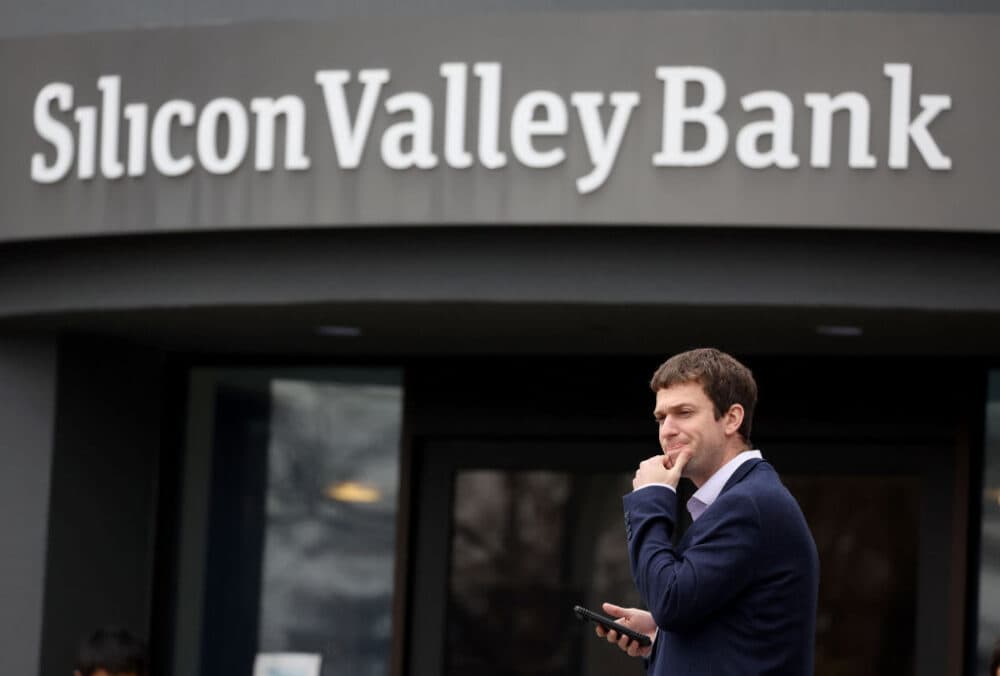Advertisement
Silicon Valley Bank's collapse: What happens when mid-sized banks get too big to fail
Resume
In a matter of days, America faced two of the three largest bank failures in its history. Silicon Valley Bank and Signature Bank held combined assets of nearly $320 billion.
In the eyes of the law, neither was big enough to be considered a “systemically important financial institution.”
“In any other country in the world, they would be financial juggernauts," Peter Conti-Brown says.
President Joe Biden says more banks are due for stricter regulatory scrutiny.
“I’m going to ask Congress and the banking regulators to strengthen the rules for banks to make it less likely that this kind of bank failure will happen again and to protect American jobs and small businesses," President Joe Biden says.
Today, On Point: What happens when so-called mid-sized banks get too big to fail?
Guests
Peter Conti-Brown, associate professor of financial regulation at the Wharton School of the University of Pennsylvania. Co-director of the Wharton Initiative on Financial Policy and Regulation. (@PeterContiBrown)
Saule Omarova, professor of law at Cornell University who specializes in regulation of financial institutions and banking law. Former special advisor for regulatory policy at the U.S. Department of the Treasury. (@STOmarova)
Interview Highlights
On what happened at Silicon Valley Bank
Peter Conti-Brown: "The first place to look is the bankers themselves. The business of banking has become vastly complex in the 21st century, over many decades, even centuries of increasing complexity. But it's also really simple to reduce. If you want to be a profitable bank, you borrow money at an interest rate and then you lend it out at a higher interest rate. That difference is called net interest income, but it just means that's the business of banking.
"That's what you get to do to be profitable. Silicon Valley Bank went about their business of banking by borrowing money from a very concentrated clientele all in Silicon Valley and paid out to them an interest rate which was higher than the rate that they were getting on the other side of their balance sheet. So exactly backwards. And if you're wondering, how could sophisticated bankers do that? And my answer is, I don't think these were sophisticated bankers. I think they were very bad at the business of banking. So that's the very first place we look at."
On The Silicon Valley Bank model
Peter Conti-Brown: "There's an old Saturday Night Live commercial about a bank that tries to make a lot of money just by making change and losing money in every transaction. And they were asked, how are you going to make money on this? And their answer ... volume, which is ridiculous, right? Because the more you do this, the more money you lose. And that's the Silicon Valley Bank model. How are you going to make money on this, [when] you're losing on every transaction? Their answer: volume. And what they did is they just exploded their depositor base.
"That's the liability side of their balance sheet, the money they owe to others in a single industry, so to speak. So the mega banks have so many problems, but a lack of diversification is not one of them. They're engaged in all kinds of businesses in all kinds of ways, and that's both on the liability side. In the asset side, Silicon Valley Bank went all in on two bets, both bad. The first was on liabilities. Let's explode our liability base, and the second is on the asset side.
"In 2020, they thought interest rates are zero. Let's put more than half of our assets in these plain vanilla mortgage-backed securities that pay 1.5%. And then let's just kind of ignore it for a few years, even as the Fed is sending a signal to everyone in the global economy, inflation's getting out of hand. We're going to start raising interest rates and we're going to raise them a. Aggressively. And so far, as we can tell, the bankers, they just kept their heads in the sand during that entire time."
On a fragility in Silicon Valley's asset and liability side
Saule Omarova: "That's what's so striking about that particular institution's balance sheet. How can you not see the fact that all of your deposits are ... so easy to withdraw? All these deposits. Because they are deposits by wholesale depositors. Big, big venture capital firms and their tech portfolio companies and so forth. And also all your money is basically sitting in this portfolio of securities. But I think there is a reason why SVB was such a bad bank, because it really wasn't a bank.
"It was more like an investment fund that had this sort of charter, this license to take deposits that are the cheapest form of funding. And it's interesting just to sort of add to Peter's wonderful description of what went wrong there. SVB was also a very powerful player in Silicon Valley. Beyond just providing deposits or even loans, it was a power broker.
"It had its own venture capital arm. It provided investment banking services. It introduced tech companies to various VC funders and so forth. And perhaps that's in part why all of those tech companies and DC firms kept their money. There are huge uninsured deposits at SVB and didn't break them up into small insured chunks, but that's basically telling us how complicated the picture is."
Should these banks have been allowed to fail?
Peter Conti-Brown: "Making them one of two things is true either. Either the Fed, FDIC and Treasury overreacted here and provided for very wealthy individuals and startup and other companies, some extremely large, some smaller supported by concentrated wealth in our country. And either the government then walked in and said to these wealthy institutions, you don't have to bear the downside risk of your choices.
"You're not legally entitled to this government support, but we're going to give it to you. And so either it's that, which is toxic to our politics and to our society. Or the Fed, Treasury and FDIC responded as we want financial crisis fighters to respond, which is our banking system is melting down. And this is a banking crisis. And so we have to hold our noses and guarantee these private actors, because if we don't, then everything will stop. If the second is true, and then we have to ask ourselves, what was the point of the last 15 years of financial reform?"
This program aired on March 22, 2023.

